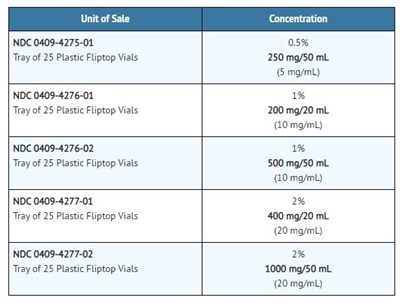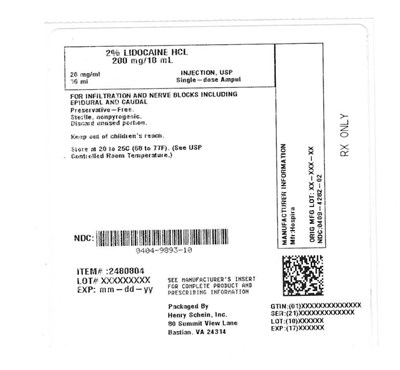Product Images Lidocaine Hydrochloride
View Photos of Packaging, Labels & Appearance
Product Label Images
The following 10 images provide visual information about the product associated with Lidocaine Hydrochloride NDC 0404-9893 by Henry Schein, Inc., such as packaging, labeling, and the appearance of the drug itself. This resource could be helpful for medical professionals, pharmacists, and patients seeking to verify medication information and ensure they have the correct product.
Image1.jpg - Image1

This appears to be a table showing the concentration of Lidocaine hydrochloride (an anesthetic medication) and sodium chloride in different solutions. The table shows the various concentrations of lidocaine hydrochloride (5, 10, 15, and 20 milligrams per milliliter), as well as the corresponding concentration of sodium chloride in those solutions (ranging from 6 to 65 milligrams per milliliter).*
Image2.jpg - Image2

This is a list of drugs that have been associated with methemoglobinemia, a condition in which the blood is unable to deliver oxygen efficiently to the body's tissues. The drugs are categorized into various classes including Nitrates/Nitrites, Local anesthetics, Antineoplastic agents, Antibiotics, Antimalarials, Anticonvulsants, and Other drugs. Examples of drugs associated with methemoglobinemia include nitric oxide, nitroglycerin, nitroprusside, nitrous oxide, dapsone, phenobarbital, and quinine.*
Image3.jpg - Image3

This is a product listing of medical containers for drugs, including 30 mL single-dose tear-top vials, 20 mL single-dose ampuls, and 10 mL single-dose ampuls.*
Image4.jpg - Image4

Table 1 Recommended Dosages: This appears to be a medical dosage table for different types of anesthesia for various medical procedures. The table lists the recommended dosages for different types of injections, nerve blocks, and anesthesia for specific body areas such as epidural or thoracic regions. The dose is determined by the number of dermatomes (a specific part of the skin supplied by a single nerve) to be anesthetized.*
Image5.jpg - Image5

The text describes different pharmaceutical products available for sale with their NDC numbers, unit of sale, and concentration. These products include Glass Teartop Vials, Glass Ampuls, and Cartons with varying amounts of drug concentration (ranging from 5% to 15%). The products come in trays or cases and have different mg/mL ratios.*
Image6.jpg - Image6

Unit of Sale: 5 clamcells containing 5 ampuls (50mg/mL) per clamcell (10 mg/mL), NDC 0409-4713-02, and 5 cartons containing 10 ampuls (20mg/2mL) per carton (10 mg/mL), NDC 0409-4713-32, and 5 clamcells containing 5 ampuls (40mg/2mL) per clamcell (20mg/mL), NDC 0409-4282-01 are information about the packaging and concentration of a drug.*
Image7.jpg - Image7

This text provides information about different units of sale and their corresponding NDC (National Drug Code) for Concentr. The product is available in different concentrations: 05%, 1%, and 2% and comes in trays of 25 plastic fliptop vials with varying quantities of mg and ml. The available concentrations are 250 mg/50 mL, 200 mg/20 mL, 500 mg/50 mL, 400 mg/20 mL, and 1000 mg/50 mL.*
Label1.jpg - Label1

This is a description of a medication that contains 2% Lidocaine HCL, which is used for infiltration and nerve blocks. This medication is suitable for epidurals and gaugal procedures. The medication is available in a 200 mg/10 mL single-dose ampule, and it is preservative-free, sterile, and apyrogenic. The unused portion of the medication should be discarded, and it should be kept out of children's reach. The pack comes with a lot number, and it has to be stored at 20-26C (68 to 77F). The package is from Henry Schein, Inc. The other text appears to be unrelated and not discernible.*
* The product label images have been analyzed using a combination of traditional computing and machine learning techniques. It should be noted that the descriptions provided may not be entirely accurate as they are experimental in nature. Use the information in this page at your own discretion and risk.

